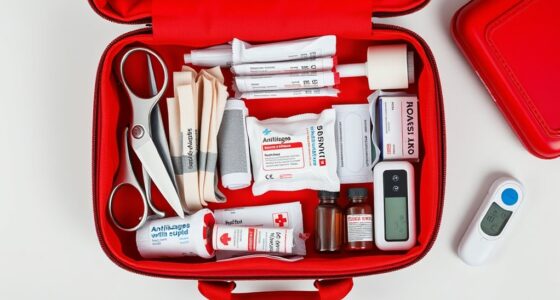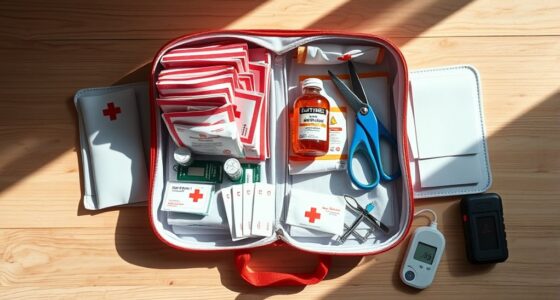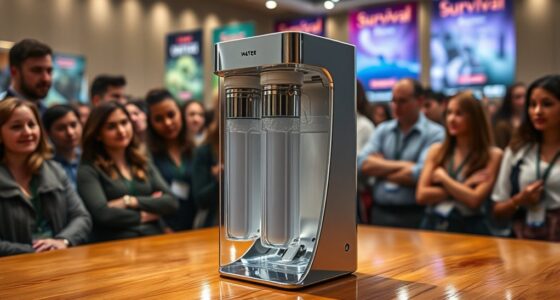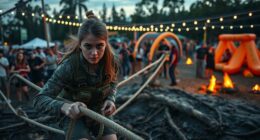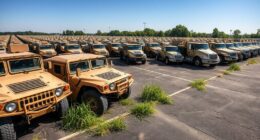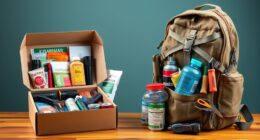Using signal mirrors, whistles, and flares together boosts your chances of quick rescue. Aim your mirror toward the sun to produce flashes that attract attention from afar. Blow your whistle in repeated patterns, like three blasts, to signal distress clearly. Use flares at night or in low light to create bright spots that stand out. Mastering these tools increases visibility and audibility, helping rescuers find you faster—continue exploring how to use each device effectively.
Key Takeaways
- Use signal mirrors to reflect sunlight directly toward rescuers or aircraft for long-distance visibility.
- Blow whistles in distinct patterns, like three blasts, to attract attention effectively.
- Deploy flares at night or in low-light conditions to produce bright light and smoke signals.
- Combine multiple signaling tools—mirrors, whistles, and flares—for maximum rescue visibility.
- Practice proper aiming, timing, and safety procedures to ensure clear, effective signals.

When you’re stranded or in an emergency situation, knowing how to signal for help can make all the difference. Your ability to attract attention quickly could be the key to rescue, so it’s crucial to carry effective signaling tools like signal mirrors, whistles, and flares. Each of these devices serves a specific purpose and can be used together to maximize your chances of being seen or heard. Understanding how to use them properly ensures you get found faster and increases your safety in critical moments.
Knowing how to signal for help with mirrors, whistles, and flares can be lifesaving in emergencies.
A signal mirror is one of the simplest yet most powerful tools you can have on hand. It works by reflecting sunlight into distant eyes, and it’s effective over long distances if used correctly. To use a mirror effectively, hold it flat in your palm, angle it toward the sun, and aim the reflected beam at a distant observer—either a rescue aircraft or someone on the ground. Your goal is to create a bright, focused flash that catches their attention. Practice aiming the mirror in different directions, especially toward aircraft or open areas where your signal might be visible. Remember, the key is to make your signal as bright and consistent as possible. Using a mirror also allows you to communicate with rescue teams if they can see your flashes, especially when verbal signals aren’t possible. Additionally, choosing a mirror with a high-quality reflective surface can improve the effectiveness of your signals.
A whistle is another essential signaling device because it produces a loud, piercing sound that can be heard over considerable distances and through obstacles like dense foliage or rough terrain. The advantage of a whistle is that it requires minimal effort to operate, and you can blow it continuously or in a pattern to catch the attention of nearby rescuers or passersby. Three blasts are generally recognized as a distress signal, and repeating this pattern helps ensure your signal isn’t missed. Whistles are lightweight, affordable, and reliable, making them a must-have part of any survival kit. Keep it accessible so you can use it quickly in an emergency.
Flares are highly visible and can signal your location at night or during low-light conditions. They produce bright light and sometimes smoke, making them effective for daytime and nighttime signaling. When deploying a flare, follow the manufacturer’s instructions carefully. Hold it away from your body, point it toward the sky, and ignite it in an open area free of obstructions. Flares are especially useful when you need to attract attention from a distance or mark your position for aerial rescue. Be aware of wind conditions, and never look directly at the flare’s flame or smoke to prevent injury. Using signal tools like flares in combination with mirrors and whistles significantly improves your chances of being rescued quickly.
Frequently Asked Questions
How Do I Choose the Best Signaling Device for Different Environments?
You should pick a signaling device based on your environment’s visibility and noise levels. In open areas, mirrors and flares work best because they catch the sun or create bright flashes. If you’re in dense woods or noisy surroundings, whistles are more effective for alerting rescuers nearby. Always carry a versatile mix, so you’re prepared whether you’re in a desert, forest, or mountain terrain, ensuring you’ll get noticed faster.
What Maintenance Is Required to Keep Signaling Devices Effective?
You should regularly inspect your signaling devices to guarantee they’re in working condition. Clean mirrors and reflective surfaces to remove dirt and smudges, check batteries or fuel levels for electronic signals, and ensure whistles and flares are intact without corrosion or damage. Store all devices in a dry, accessible place, and test them periodically if possible. Proper maintenance keeps your signals reliable when you need them most, increasing your chances of being found quickly.
Can Signaling Devices Be Used in Extreme Weather Conditions?
Yes, signaling devices can be used in extreme weather conditions, but you need to be cautious. In heavy rain or fog, visibility decreases, so make certain your mirror is clean and angled correctly. Flares work well in wind but avoid using them in rain to prevent malfunctions. Whistles are reliable in storms, but your best bet is to keep devices in waterproof containers and check them regularly to guarantee they’re operational when needed.
Are There Legal Restrictions on Using Signaling Devices in Certain Areas?
Imagine your signaling device as a lighthouse guiding rescuers to your stranded boat. Yes, there are legal restrictions in some areas, like national parks or protected wildlife zones, where you might need permits or face penalties. Always check local regulations before using your signaling tools. Respecting these rules not only keeps you safe but also preserves the environment, ensuring your signals serve their purpose without unintended consequences.
How Effective Are Signaling Devices During Nighttime or Low Visibility?
Signaling devices are highly effective during nighttime or low visibility because they reflect light or produce visible signals that can catch someone’s attention from a distance. A signal mirror can reflect sunlight to attract rescue teams, while flares emit bright, noticeable flashes. Whistles can be heard over long distances, especially in quiet environments. Always carry these devices and use them strategically to improve your chances of being found quickly in low-light conditions.
Conclusion
By mastering signal mirrors, whistles, and flares, you turn yourself into a blazing beacon of hope in the wilderness. Your signals will cut through the thickest forest or darkest night like a supernova, drawing rescuers from miles away in an instant. With these tools, you hold the power to be found faster than you ever imagined—making rescue nearly inevitable. Stay prepared, stay loud, and turn your survival into a story of triumph!




